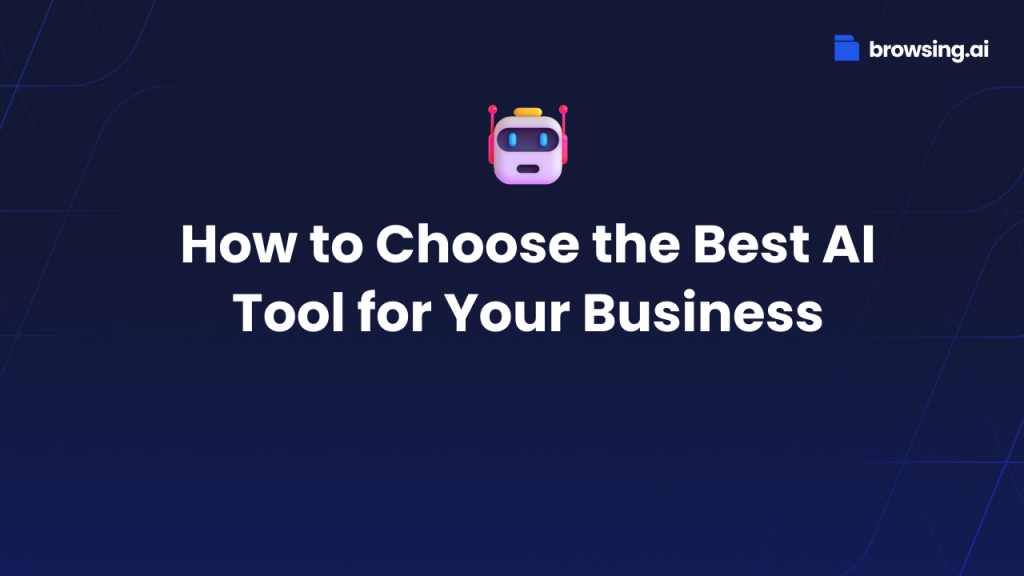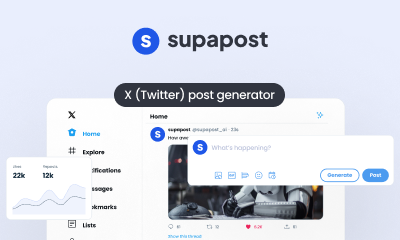AI tools are becoming more important every day for businesses of all sizes. Whether it’s automating those repetitive tasks, offering data-driven insights, or making marketing efforts more effective, AI has the potential to completely transform how you operate. But with so many options out there—especially in directories like browsing.ai—it can be difficult to know where to begin. That’s why we’re here: to help you navigate the process of finding the best AI tool for your business in a straightforward way. Let’s dive in!
Step 1: Define Your Business Goals and Needs
Before you get lost in the sea of AI options, it’s essential to take a moment to clarify what you really need. What do you hope to achieve by adopting AI? Are you looking to improve customer service with chatbots? Automate data analysis? Or maybe you want to enhance your marketing efforts to better reach your audience? Having a clear vision from the start will make the whole journey much more manageable.
Key Considerations:
- What specific challenge are you trying to solve?
- Which tasks or workflows could benefit from automation?
- Are you aiming for a short-term solution or a long-term transformation?
Think about it like planning a vacation—you need to know where you want to go and why. The clearer your understanding of your destination, the better you can plan the journey. This will also help you justify the investment to your team and stakeholders, making sure everyone is on the same page.
Step 2: Identify the Type of AI Tool You Need
Once you have a clear idea of your goals, it’s time to determine what type of AI tool will help you reach them. AI tools come in many shapes and sizes, and choosing the right one is crucial. The more specifically you can define what you’re looking for, the easier it will be to find a good match.
Popular AI Tool Categories:
- AI for Automation: Tools like Robotic Process Automation (RPA) and AI chatbots are perfect for taking care of those repetitive tasks, allowing your team to focus on more important things.
- AI for Marketing: Tools that help with customer targeting, ad optimization, and content creation. These tools can help you create more effective marketing campaigns and improve audience engagement.
- AI for Data Analysis: Machine learning platforms, predictive analytics, and business intelligence tools can help you make sense of all your business data. With data-driven decisions, you can stay ahead of the curve.
- AI for Customer Support: AI-powered chatbots or automated ticketing systems can improve response times and overall customer satisfaction by being there 24/7.
By narrowing down the type of AI you need, you can filter through all the noise and focus only on relevant options. This will save you a lot of time and may even lead you to discover innovative tools that you hadn’t considered before.
Step 3: Research and Compare AI Tools
Now that you know what kind of tool you need, it’s time to do some research. This is where directories like browsing.ai come in handy. You’ll probably come across dozens of potential solutions, but don’t be intimidated—taking the time to compare them will ensure you make the right decision.
Tips for Effective Research:
- Read Reviews: Reviews from real users can give you insight into the tool’s strengths and weaknesses. Are users happy with the product? How responsive is customer support? These reviews can be eye-opening.
- Check Case Studies: Some tools provide case studies from businesses that have used them successfully. These can give you a sense of how the tool works in real-world scenarios and can offer ideas on how to best implement it for your own needs.
- Compare Features: Make a list of must-have features, then see how different tools stack up. Some tools are generalists, while others specialize in one area. Knowing what’s most important to you can help you narrow down the list.
- Talk to Sales Reps: Don’t shy away from contacting sales reps for demos or asking questions. They can provide tailored information that’s specific to your needs and show you exactly how the tool could benefit your business.
Step 4: Evaluate Pricing and ROI
AI tools vary widely in terms of cost—some are free, while others may require a significant investment. Before committing to any tool, think about how much you’re willing to invest and what you expect in return. Your goal should be to strike a balance between cost and value.
Considerations for Pricing:
- Free vs. Paid Tools: Many tools have free versions or offer trial periods. If you’re hesitant about spending, try these out first to understand the tool’s value before making a full commitment.
- Value for Money: Consider how much time, stress, or resources the tool will save you. Will it make your processes faster? Improve the quality of your work? A tool is only worth it if it provides a return on your investment.
- Scalability: Will the tool be able to grow with your business? Scalability is important, especially if you have expansion plans. Make sure the tool can handle increased workloads or more advanced functionalities as your business grows.
- Hidden Costs: Keep an eye out for potential hidden costs, like premium features or extra support fees. You want to understand the total cost so that there are no surprises down the line.
Step 5: Test the Tool with a Pilot Project
It’s always a good idea to test a tool before fully committing. Try using the AI tool in a small-scale project to see how it performs in real situations. Pilot projects are great because they let you experiment without causing major disruptions to your existing workflows.
Pilot Project Ideas:
- Customer Support: Set up an AI chatbot to manage a few customer inquiries and measure its response rate and effectiveness.
- Data Analysis: Use an AI tool to analyze a small dataset, like recent sales figures or customer behavior trends. Compare its insights with those from your current analysis methods.
- Marketing Automation: Run a short, targeted campaign using an AI tool that automates emails or social media. Observe the engagement rates and ROI to see if it meets your expectations.
Pilot testing also allows you to discover any challenges in integration or usability before fully implementing the tool, saving you time and frustration in the long run.
Step 6: Assess Integration and User Experience
No matter how great an AI tool sounds, if it doesn’t integrate well with your existing systems, it will likely cause more frustration than it’s worth. It’s important that the tool fits seamlessly into your current setup and that it’s easy for your team to use.
Key Factors to Check:
- Ease of Integration: Can the tool easily integrate with your current CRM, project management software, or other systems? The smoother the integration, the faster you’ll see the benefits.
- User-Friendliness: The more intuitive the tool, the better. If it’s overly complex, you might face resistance from your team. An easy-to-use interface will make adoption much smoother and ensure the tool is used effectively.
- Support and Documentation: Look for tools that provide thorough support and onboarding resources, like tutorials, knowledge bases, or live support. Adequate support can make all the difference when you run into questions or issues during the setup.
Step 7: Measure Success and Adapt
Once you’ve implemented the AI tool, it’s crucial to track how well it’s working. Set specific metrics for success and monitor them regularly to see if the tool is meeting your expectations.
Metrics to Measure:
- Efficiency Gains: Calculate the time or effort saved by using the AI tool. Measure the impact in terms of hours saved, tasks completed faster, or even employee satisfaction.
- Improved Accuracy: See if there’s been a reduction in errors or improvements in decision-making quality. For example, are customers happier with fewer mistakes, or has data entry become more reliable?
- Customer Impact: Is the tool enhancing the customer experience? Are they receiving faster responses or more personalized interactions?
- Financial Impact: Keep an eye on whether the tool is contributing to increased revenue or reduced costs. ROI doesn’t always come down to dollars—it could also mean happier customers or smoother operations.
If the tool isn’t delivering the results you hoped for, don’t hesitate to reassess. Head back to the directory, research more, and try out different solutions. It’s all about finding the perfect fit for your needs.
Conclusion
Choosing the right AI tool for your business might seem challenging, but it doesn’t have to be. By following these steps—defining your goals, doing your research, testing, and measuring results—you can find the AI solution that works best for you. The journey of selecting an AI tool is as important as the tool itself, and making thoughtful choices now will pay dividends in the long run. With resources like browsing.ai, the process becomes much simpler. Keep experimenting, be open to new possibilities, and eventually, you’ll find the tool that will make a real difference for your business. Good luck, and happy hunting!

